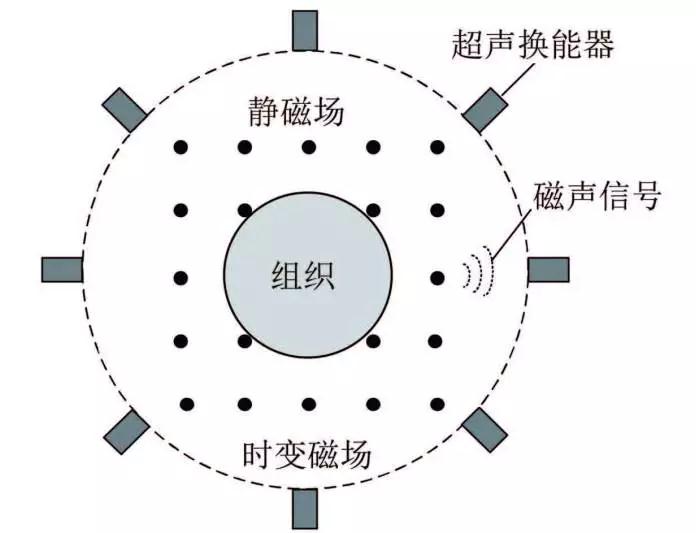Ultrasonic and electromagnetic detection technology is the most mature, fastest-developing and widely used industrial non-destructive testing method.
By combining ultrasound and electromagnetic detection, a non-destructive detection technology based on multi-physics coupling (Magnetoacoustic Tomography with Magnetic Induction (MAT-MI) is formed, which can fully exploit the advantages of ultrasound and electromagnetic detection. More information on the test piece and its defects.
Different from the conventional detection method, MAT-MI can not only detect the geometry and position of the defect, but also "functional" imaging the tested part and its defects, and obtain the conductivity distribution inside the test piece. Accurately identify and locate defects, especially for fast, large-area non-contact inspection of sheet metal.
Inductive magneto-acoustic imaging technology in the biological field
In 2005, HE et al. of the University of Minnesota merged magnetic induction technology with ultrasonic tomography imaging technology, and proposed a new biological functional imaging method—inductive magneto-acoustic imaging technology. The technology electromagnetically excites the imaging target simultaneously by the static magnetic field and the pulse alternating magnetic field, and uses the ultrasonic transducer to collect the magnetic acoustic signal generated by the measured tissue, and analyzes and calculates the magnetic acoustic signal, which can be used for reconstructing the biological tissue interior. Conductivity distribution. This technology combines the high contrast of bioelectrical impedance imaging with the high spatial resolution of ultrasound tomography (the theoretical resolution of up to 0.3mm) to avoid shielding effects in areas such as breast cancer screening and liver function imaging. The feasibility has been verified.
The biological tissue to be tested is placed in a uniformly distributed static magnetic field, and a pulse excitation current is introduced into the toroidal coil to generate a time-varying magnetic field parallel to the direction of the static magnetic field inside the tissue, thereby inducing and exciting current in the tissue. Eddy currents of the same frequency. At the same time, under the action of static magnetic field, the induced eddy current generates the same Lorentz force in the tissue, which causes the periodic local vibration of the charged particles in the tissue to be tested, and propagates in the form of ultrasonic waves to form a magnetic acoustic signal. . The ultrasonic transducer is used to collect the magnetic acoustic signal around the tissue and convert it into a sound pressure signal, and then amplify, filter and store the same, and then reconstruct the conductivity distribution map reflecting the physiological function of the biological tissue.
Inductive magneto-acoustic non-destructive testing technology

The principle of MAT-MI imaging
Defects inside the metal material disturb the distribution of the induced eddy current, and thus it is possible to determine whether or not there is a defect by detecting the electrical characteristics inside the test piece. MAT-MI non-destructive testing technology is a new method for non-destructive testing by plotting the internal conductivity distribution of the tested parts. By analyzing the changes in electrical impedance characteristics caused by the magneto-acoustic effect, the defects of the test piece are quantitatively analyzed. Spatial resolution.
With the increasing demand for non-destructive testing technology in the industrial field, multi-modal non-destructive testing technology is increasingly used. The combination of different testing technologies can improve the reliability of inspection. The development of composite non-destructive testing system is future industrial non-destructive. The main development trend in the field of detection.
MAT-MI non-destructive testing technology is a new dynamic non-destructive testing method with multi-physics coupling. It combines electromagnetics, acoustics and mechanics. It uses electromagnetic method to induce induced eddy currents in the tested metal materials. The magnetoacoustic signal provides information on the electrical characteristics of the defect and is used for further conductivity image reconstruction.
MAT-MI non-destructive testing technology can effectively detect defects on the surface or inside of the sample without direct contact. It has the advantages of high sensitivity, high resolution, non-contact, no coupling agent, and wide range of rapid detection. For the defect detection of conductivity anisotropic metal materials, it is one of the research focus and difficulty of MAT-MI non-destructive testing technology. By establishing a conductivity anisotropy model and using finite element analysis technology to numerically simulate the MAT-MI positive problem, it can provide ideas and basis for effectively solving this problem.
-
 Sales@hata-ndt.com
Sales@hata-ndt.com -
 0086-0371-86172891
0086-0371-86172891










